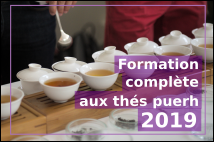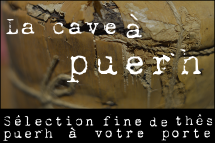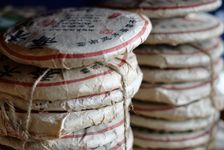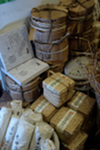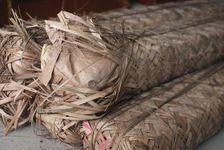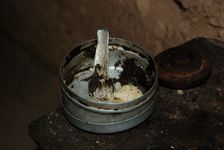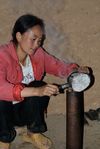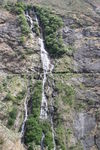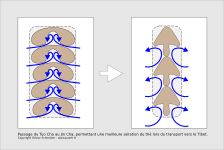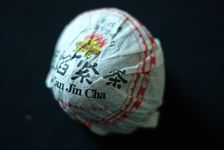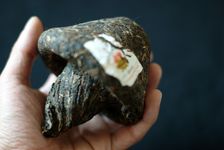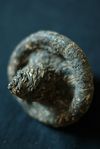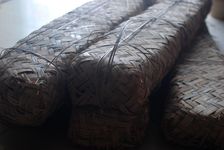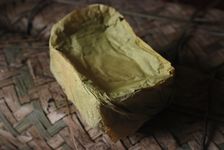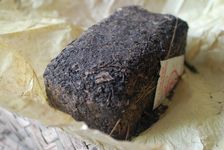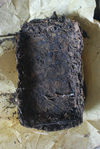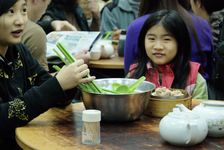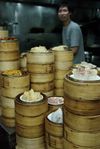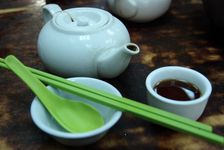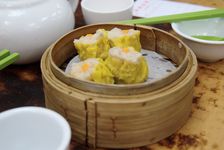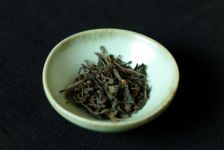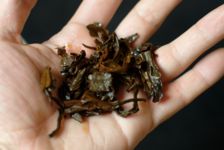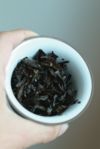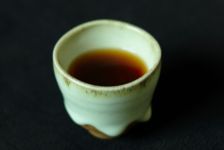 This page is not a real translation but just an automatic translation generated by computer of the original article, written in French language! Its not good... but better than nothing!
This page is not a real translation but just an automatic translation generated by computer of the original article, written in French language! Its not good... but better than nothing!Want to help us do diffuse puerh tea culture in english, by providing a better (or corrected) translation?
Please contact us!

Puerh tea differs from other types of teas in many respects, including its ability to evolve over time. Often compared to wine, tea puerh (Pu Er tea) does have the reputation to improve with age, or where the vast majority of teas, whether green, white or black quickly lose their wealth in contact with air and therefore drink as soon after harvest.
As we discuss in this article quickly and more deeply in a future, the question is more mixed than that, and the adage that the more the better puerh (Pu Er tea) is old he will not take money for content. Indeed, it is best to see aged puerh (Pu Er tea) as a class full of tea, a class of rich and fabulous diversity, but that can not be regarded as objectively superior.
The aged are not puerh (Pu Er tea) least one dimension of this fascinating family of tea, are practically a whole culture, including Hong Kong and Taiwan, and have long been highly sought after and appreciated by fans.
But where does this habit not only of aging the puerh, but also in many cases to assist the aging in a more or less artificial? So often we like to remember that culture is puerh (Pu Er tea) the millennium, the tea consumed by minorities of Yunnan it there's thousands of years, and we do not know ultimately not much, was without a doubt crafted and prepared in a manner far different than the one we're used to today. The same enthusiasm that we see now for older puerh (Pu Er tea) is a relatively recent phenomenon that actually appears in the late 20th century. If this latest attraction for puerh (Pu Er tea) old seems to be the result of an earlier culture around this post-fermented tea, she hides in the folds of history and still partly mysterious.
ancestral practices of post fermentation among ethnic minorities in Yunnan
Through the trees they have left us we know that ethnic groups who inhabited the present Yunnan it there's thousands of years already knew and mastered the tea culture (see The origins of tea ). This is particularly the case of Pu, which décendraient the Blang, Wa and De'ang current, which left us many tea gardens dating back sometimes over 1000 years. Well unfortunately if these old trees, real fossils in the history of tea, are still alive, few traces of these reports qu'entretenaient ethnicities with tea during this period have withstood time, if not some traditional practices, transmitted orally from generation to generation.

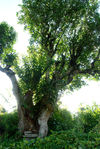

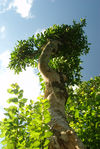
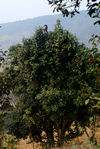
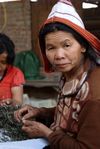
- 1. Women aged Bulang to Shuangjiang
- 2. Millennium Tree in the region of Fengqing
- 3. Bulang Woman picking tea leaves
- 4. Millennium Tree in the region of Fengqing
- 5. Tree old plantation in the region of Pu Er
- 6. Woman to Jino Jino Shan
Among these practices, there's Bulang in making a tea out of the ordinary Chinese Suan called Cha (tea or tea sour acid) whose origins come from an ancient past. Traditionally baked for festivals and rituals, especially weddings (who could have no place Suan Cha) is a rare and precious tea, which can not cross in the intimacy of a family Bulangs and the making of which was unfortunately a strong tendency to disappear today.


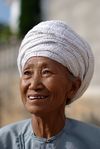


- 1. Village at Blang Blang Shan
- 2. Woman in Blang Blang Shan
- 3. Woman to Bulang Shuangjiang
- 5. Women Bulang during traditional festivities in Shuangjiang
Based on the same leaves as those used for making conventional puerh, the Suan Cha is the result of a unique traditional knowledge and the culmination of a long phenomenon of post-fermentation. After boiling and have undergone various transformations leaves are placed in a section of bamboo, sealed with soil and then wrapped in banana leaves before being entérée in the soil. They will remain there six months, bathed by the warmth and natural moisture of the earth before being extracted for consumption. Tea at the Blang was usually eaten, supplemented with different foods and spices, but it can also be brewed just for drinking more conventionally as we shall see immediately.
 Chargement du thé...
Chargement du thé...
But Bulang were not the only inhabitants of this area, not only to eat the tea leaves, but especially to fermenting them for preservation. Similar practices are found in different ethnic groups from Burma and northern Thailand with teas that are respectively Lahpet name is Miang and-So. Like Cha Bulang Suan, it's fresh tea leaves, left fermented for several months, particularly in sections of bamboo, before being consumed, eaten as a salad, seasoned with garlic, peas, peanut , tomatoes, fish sauce, sesame seeds, ginger, shrimp, etc., or simply chewed.
Behind these practices and post-fermentation seems to be in first place the custom of eating the fresh tea leaves (not dried), including the kitchen, and found in many ethnic groups such as Bulang or Jino. The tea leaves can not be eaten fresh all the year their fermentation and preservation in this form appears as an alternative for months without a harvest, as is still the standard in Yunnan with many vegetables, fermented jars and called Suan Tzai, sour or acid vegetables (what the English call picked or Preserved and for which we have not really appropriate French translation).
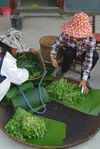
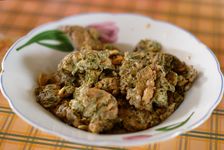
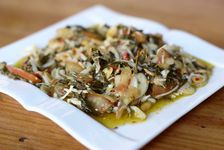
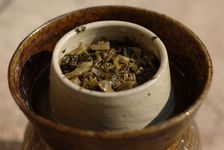
- 1. Return of picking fresh plants in the forest in Jinuo
- 2. Flat Jinuo composed of fresh tea leaves
- 3. Lahpet-So (fresh tea leaves) in Burma
- 4. Jarre at Suan Tzai (preserved vegetables) to Lincang
Having said these ancient practices of post-fermentation tea seem still limited, and the vast majority of tea was most probably in ancient times eaten fresh, either eaten or brewed. Besides the consumption of fresh leaves it is also possible that a proportion of tea leaves underwent a rudimentary work before being infused, resulting in a tea probably blaming himself more or less than the current gross puerh (Pu Er tea) or tea Green, as we can see for example in northern Laos, particularly in the area where Phong Sali from ancient trees identical to those growing in the region of Wu Yi local populations produce a rudimentary form puerh (Pu Er tea) tea. Briefly worked, compared to a puerh, these sheets are then compressed into small sections of bamboo to take shape and then extracted to be sold as tea bought at a market in northern Laos:
 Chargement du thé...
Chargement du thé...
And if the practice of post fermentation puerh (Pu Er tea) was likely not the most common use among ethnic groups inhabiting the Yunnan present there are over 1000 years ago, examples such as Suan Cha Bulang, tend still to show that these ethnic groups had already discovered in the distant past the possibilities of post-fermentation offered by these tea leaves, and were eating these fermented teas post. But although we can see through these practices the first signs of maturation puerh (Pu Er tea) aware, we can have more cons in doubt about the parentage of one hand between these traditional, isolated in remote areas of Yunnan, and secondly the future history of puerh (Pu Er tea) old and diffusion through and out of mainland China, the two phenomena are probably dissociated.
The authors generally prefer to talk about this "discovery" of the maturation of puerh, refer to the famous tea route and horses, both for historical reasons as we shall see to inspire dreams, and make it more exotic.
Roads Tea and Cha Xiao Bian
Less known than the famous Silk Road that is called the tea route, however, was one of the largest exchange network, export and trade of Chinese history. More than a single road it is actually a vast network of roads, starting mainly in Yunnan and Sichuan provinces, especially in Russia and ending in Burma to Tibet but also in Thailand in Laos or Vietnam.
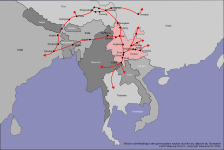




- 1. Map of main roads tea
- 2. Fragment of the road Wu Yi tea
- 4. Fragment of the tea route to the North Yunnan
- 5. Baskets for transporting tea mule
tea against horses ...
Among them the road to Tibet, also known ancient tea route and horses (Cha Ma Gu Da), particularly well known, play a crucial role in the development of Chinese tea, especially in Yunnan. Archaeological studies tend to show that sections of this road there's there already existed several thousand years ago, and have summers used by ethnic groups of the time, but it was not, however, that during the Tang dynasty ( 618-907) that this road is formalized and truly took off as a trade route tea ... and Horses!
Horses, and especially the good war horses like the famous Heavenly Horses of Urbekistant were indeed one of many whose empire was eagerly need to allow for expansion, and without which its future was in danger. Excluding these, rare in China abounded in the west especially in the territories Beanies, Mongols and Tibetans.
This trade in horses in western China and their import is nothing, strictly speaking, the tea route and was notably one of the reasons for the previous Silk Road. However, the fall of the latter with that of the monopoly of the Chinese Silk, coincides almost exactly with the advent of a new currency: the tea.
Thus was born the famous roads of tea and horses, by which the horses were exchanged against Tibetans cargoes of tea, mainly from Sichuan and Yunnan, and the tea was actually appeared to Tibet to become very People at the end of the Tang Dynasty.
The Tibetans, who especially in winters living in difficult climatic conditions, with a diet rich in dried meat and dairy products, but low in fruits and vegetables, especially appreciated teas such as puerh. The latter, prepared in a soup rich in salt rancid butter were not only a high-calorie beverage rich in nutrients, but also through propriétées puerh (Pu Er tea) of considerable assistance in digestion and assimilation of a diet rich fat. This soon made the tea and puerh (Pu Er tea) Sichuan almost a daily need in the eyes of Tibetan life, and smuggling of tea route and horses quickly became prosperous on both sides of the Himalaya.
But to get to Tibet, the road is long and far from obvious, especially it there's 1000 years ago! Twisting of the mountains of Yunnan to those of the Himalayas, the narrow path crosses a succession of mountains increasingly steep, dramatic cliffs along, through the gorges by unlikely since become famous suspension bridges, all under conditions of the most difficult climate, much of the road by the seasons in the rain or through snow storms. Particularly in the snow, cold and violence that defied the tea in the Himalayas crossing an imposing rock that separates the Tibetan Plateau regions of Yunnan and Sichuan.
And so in these conditions and that the puerh (Pu Er tea) was transported from southern Yunnan to Tibet. Until 20iène century still much tea was transported on their backs, some carriers can carry up to 150kg of tea as shown particularly incredible lithographs of 1868 and various photographs taken around 1900. The tea was also charged on certain sections of long processions of mules or horses rarely.
This is where was born used to compress the puerh, making transportation easier by reducing the space taken by the tea leaves, avoiding more economic to use wooden boxes, but also more resistant to the harsh conditions suffered by tea during transport, including air and moisture, particularly destructive for most teas.
It is also for certain how one would have discovered the properties of post-fermentation puerh (Pu Er tea) even if it belongs may be more legend and imagination in the history of puerh (Pu Er tea) than anything else. A legend tells that due to the difficult terrain and weather we abandon a cargo of tea on the way, then that next year they found that cargo. When tasting tea which consisted of one would then reported on the alteration of the tea and the quality of the result, thus discovering the beneficial effect of time and moisture on the aromas of puerh.
One often reads as a more pragmatic, but probably not less romanticized, that carriers and tea sellers have found that tea was better for the convoy's arrival at the outset of this one. Tea before arriving in Tibet was in effect for months packaged in paper and woven bamboo, between heat, humidity and perspiration of annimal carrying tea, and could undoubtedly greatly affected by this journey, permeated by moisture, and Occide quite fermented. Stories also tell that the cargo arrived at Lassa, tea was spread on the roads and left some days before being sold, probably to dry, reducing mold damage and some stale odors transport.
It is therefore obvious that the puerh (Pu Er tea) arriving in Tibet was marked by months of travel, was to be the result of a post-fermentation accelerated by transport conditions, and therefore that which would have tasted this tea before and after would probably noted a marked difference. Against him by exclaiming that this tea is best, thus laying the foundation stone for the culture of aging puerh, seems more drawn against the imaginary, Hong Kongers probably, than anything else.
As legend has the truth of the first Bian Xiao Cha
We can emmètre a number of doubts about the image of this "discovery" of accidental post-fermentation puerh. Firstly the lack of written evidence to my knowledge that could refer to it, and that would describe the natural transformation of puerh (Pu Er tea) during transport to Tibet or state to come by while we find many cons or write period are detailed the different quality of imported tea in Tibet (including 5 types of bricks Sichuan, their flavors and their degree of fermentation ...!), method of manufacture and packaging of these teas, as well that the way they are consumed.
But even more questions arise about the very image of this accidental discovery: the Chinese merchant who notes that his tea is the best that happened at the start, making a crucial discovery that is the cause of aged teas end that we enjoy today with a price in some tea houses ...
For handing things in context of this vision which we wonder: What, the one who has had the opportunity to taste the same tea at the start of Yunnan and Tibet has come from going to see a difference either . Whether it had any influence on the production, processing and consumption of more puerh (Pu Er tea) Yunnan is much less cons on for at least two reasons.
In the first place, the transformation of puerh (Pu Er tea) was inevitable at that time. We're there there's almost 1000 years ago, there was then no plastic bags or "cool packaging" or refrigerated cold storage, and transportation were terribly long. Today, when consuming green tea products ultra cool, who travel the world in a few hours by plane in protective pockets seems natural, it strives to recreate artificially against by the conditions for the fermentation of some puerh. But in the era of the tea route and horses the situation was diametrically opposed: the fermentation of tea leaves was not a choice but an inevitability that there was nothing, even with the best will in the world. So many were inevitably puerh (Pu Er tea) fermented to some degree, they are stored in the conditions of the time, particularly among producers of tropical areas like Xishuangbanna, or transported from one region to another, and it's finally puerh (Pu Er tea) in its cool that would be unknown outside of production areas.
Furthermore it appears on the tea route that the technical advances made gradually puerh (Pu Er tea) for packaging, especially for has to be sent to Tibet, tended towards a better protection of tea, and a minimization of the phenomenon of mold, not the otherwise. This is part of what motivated the creation of Jin Cha, puerh (Pu Er tea) compressed shaped fungus that appear between 1912 and 1917 to replace the old form of Tuo Cha (bowl) for export to Tibet, and whose form has been studied to allow better ventilation tea during transport and prevent mold caused by moisture accumulation between Tuo Cha, and avoid excessive fermentation of the leaves. It will be seen as a will and a positron radically different from the example of wet storage that will appear almost 30 years later around Hong Kong and Guangzhou, which is precisely to push the moisture until the appearance mold to the surface of the tea.
In the second place the history of tea would happen best in his journey through Tibet fermentative, and therefore show that the Chinese way of aging of this tea, we ask the "best". Tea culture in Tibet it there's 1000 years ago is far from Gung Fu Cha and art and intellectual elitist tea that grows at the same time in some Chinese environment. Tea is in Tibet is a popular product for everyday use, that is not only long boiled mixed with big doses of rancid butter and salt, but also and above all been produced with this in mind from the remains unfit the Chinese consumer.
The tea sent to Tibet and surrounding areas by the famous roads of the horses was in fact not a quality product comparable to teas that some relished at the same time inside China, but was specifically produced for export . China called the Cha Xiao Bian (边销茶), they were low-end teas, which promote the flow remains, leaves poorly worked, too old or of poor quality, see the debris swept out of the shop floor production. The quality criteria between these teas low-end product to finish in rancid butter and tea products to be consumed on the Chinese territory were so radically different, and as we have seen how these teas were consumed, and it is quite unlikely that the finding of the fermentation of these scrap of tea during their journey to Tibet them has the slightest impact on quality teas.
If I try and question the myth of Tibetan puerh (Pu Er tea) post fermentation, it is by no means to question the importance of Tibet in the history of puerh (Pu Er tea) and post-fermented teas, but instead to refocus the issue of Tibet and other border areas. In fact by making the tea route called the theater of discovery, accidental, maturation of puerh (Pu Er tea) we accessorize the situation in Tibet and other neighboring countries, to highlight the alleged (and Chinese) of this "discovery", and the alleged future exploitation of this discovery, while on the contrary it is precisely on the sidelines of the China mainland, and in these border areas, as has been the issue of post-fermented tea .
Whatever indeed the poor quality of tea exported to Tibet, or the reasons and conditions for the fermentation of the tea there was very appreciated and requested. Tibetan tea market and quickly took a significant dimension, becoming crucial to the economy of the tea of Yunnan and Sichuan. If the Han Chinese who held the tea market despised undoubtedly the quality of what they sent to Tibet, he did not neglect the profits that meant and obviously the development of these Although Xiao Cha, tea for exports in border areas, is primarily made to stick to the demand and taste of people in these areas.
To illustrate this a taste of Tibetan brick, not from Yunnan but Guei Zhou, a neighboring province. Produced in 1992 by Tong Zi, branded Jin Long (Pai) this brick has since been preserved in a natural atmosphere, and is not following a wet storage in Guangzhou or Hong Kong. It retains its original character shaped by 20 years to mature slowly and naturally.
 Chargement du thé...
Chargement du thé...
But the puerh (Pu Er tea) Yunnan was not the only Good Xiao Cha to be exported to Tibet. The current enthusiasm for puerh (Pu Er tea) is indeed often forget that the road was carrying not only tea but also the puerh (Pu Er tea) widely, and probably mostly tea compressed into bricks from Sichuan. In many write two teas are blended, and everything we associate with Tibetan tea compressed tea puerh, whereas in fact it is quite different from tea, not only by their origins but also in their production processes .. . which give us a surprisingly and otherwise to the issue of post-fermentation.
In 1872 a French missionary, Father Desgodins, described in a report because the production techniques of bricks produced for export in Sichuan to Tibet. Yet this description describes accurately what the abbot Desgodins considered the secret of success of this tea, or how the tea leaves of poor quality, plant waste and branches, were fermented to become drinkable. Now the form of the artificial fermentation approaches disturbingly of what was practiced 80 years later in Hong Kong and in the Canton area and inspire the development of Yunnan puerh (Pu Er tea) fermented modern!
The leaves, branches and other plant waste and had chopped a few inches and then placed, in layers in holes dug in the ground. If the leaves were not wet enough they poured water between each layer to allow fermentation. Everything was in a hurry to become thin and compact the hole was plugged with cover to avoid contact with air. The leaves were thus left to ferment 5-8 days.
We note also that the description of the low fermentation times, probably causing a slightly fermented tea, may be approaching an old tea naturally, not a highly fermented puerh (Pu Er tea) as we now produce artificially. The reasons for this artificial fermentation of the tea produced in Sichuan to Tibet by cons are unclear. Was it to imitate from inexpensive material, such as branches of leaves of other trees that tea, appearance and aroma of puerh (Pu Er tea) sent to Tibet from Yunnan, and it had the ability to fermented "naturally"? Or rather is it the puerh (Pu Er tea) came to fill an application by creating fermented tea tea dark Sichuan?
As a "competitor" on the market in Tibet, it is also hard to believe that mastery of Sichuan artificial fermentation of tea was unknown in Yunnan teas from these two regions cottoyant in Tibetan shops. If these fermentation techniques and assisted tea were probably known producers of tea in Yunnan may first think that it was deliberately ignored, the post-fermentation tea puerh (Pu Er tea) being any natural way and as we have seen difficult to avoid, therefore requiring no extra work. One might also think that such artificial fermentation of puerh (Pu Er tea) was well practiced in the Yunann during that period it has now has been unearthed by historians. The latter hypothesis is rather unlikely to seen the number of documents on this puerh (Pu Er tea) in Chinese archives and where it is to my knowledge never a question of artificial fermentation of puerh.
Always it is that Tibet and border areas of Yunnan is well into the 30s the main market of aged teas, or post-fermentation, fermentation is that natural or assisted. This market is also huge in that the British in the 1900s trying to conquer this market for India. But the Tibetans are not made in Indian tea and still prefer the post-fermented teas from Yunnan and Sichuan, despite efforts not to pierce the English what they treat as secret Chinese production. Several times the English try and analyze the composition of Tibetan tea bricks, look up the type of leaves other than tea present in the bricks (especially Sichuan), with some success but without successfully compete with Chinese teas. Note also the attempt through English, and that again as was the case in China, the goal was only to please the Tibetan market with a low-end tea, not improving the quality of tea is , considering the English tea sold openly in Tibet as a byproduct well below their eyes to black tea they produce in India for the European market.
But these Bian Xiao Cha is not the only face of puerh (Pu Er tea) of time, and while these cheap teas were sent to a tea puerh (Pu Er tea) is a totally different quality driving on the roads of tea in the direction of north this time, for among other finish in Beijing in the hands of the Emperor!
Road Beijing, Gong Cha, fine tea and cakes first big producers
Gong Cha, puerh (Pu Er tea) becomes imperial
Alongside the Cha Xiao Although export to countries border the puerh (Pu Er tea) was widespread and widely consumed in Yunnan since the Ming Dynasty (1368-1644), by the local population but also by the Han. These that begin to migrate in Yunnan, instaurairent gradually, especially after 1600, a military and political control of the area, but also a strict control and taxation of the tea trade, become a commodity particularly important, especially on the local market.
Tea, harvested and worked mostly by ethnic groups in Yunnan Pu'er was thus centralized (Simao), to be taxed by the empire before being sold, including many Han merchants from Jiangxi. Moreover smuggling and direct sales of tea, strictly prohibited and punishable by the empire was as common and practiced by the local ethnic groups than the Han merchant, but also by a number of officials working for the Emperor and involved in the illegal trade of tea, helping to fuel the local market puerh (Pu Er tea) quality tea and tea products especially for the emperor.
For the most prestigious puerh (Pu Er tea) were not officially sold in the market, but delivered to the gates of Beijing Forbidden cited. It was indeed in ancient China used to offer (or sell) a number of goods to the emperor, such as in the case of Xushuangbanna tableware in gold and silver, ivory, of horses or elephants what appeared as if a form of taxation or a mark of devotion or gratitude to the Emperor. These high-end goods, from all over China were generally representative of a form of local specialty and also represented a particular region. Not only used or consumed by the course, they were more especially intended as presents, relatives or guests of the government of the emperor.
The entrance to the tea in the list of offerings to the emperor dates from the Tang Dynasty (618-907). An institution is thus created around this gong cha (literally tea as an offering), and the best teas of China are annually purchased, processed, and transported to the quoted prohibited where there is a huge storage space dedicated to tea, in which twenty people were working. The puerh (Pu Er tea) when it will become to each gong in 1732, as evidenced by the records of the cited prohibited. At the initiative of Gold Tai, major political figure of this period and whose name appears on Gong Cha sent to the Emperor, the entrance of the imperial palace puerh (Pu Er tea) follows the seizure of political control of Xishuangbanna and Pu Er by the empire and the establishment of a central sales and tea taxation by the state.
Thus the history of Puerh Cha Gong starts to last nearly 200 years of the Qing Dynasty (1644-1912), during which the best leaves puerh (Pu Er tea) each year were ordered by the Emperor, and sent to Yunnan the quoted prohibited. But to return to the issue of post-fermentation, it does not seem that this production of a puerh (Pu Er tea) end to the Emperor is accompanied by a search of maturation of these teas. Records concerning the production of Gong Cha are indeed part of the harvest (made for the purpose of spring tea buds white), the steaming and compression into a ball, and it seems that everything was done work to achieve this tea as fresh as possible until Beijing, where tea was probably enjoyed fresh.
You can of course assume that before consumption, the puerh (Pu Er tea) were kept for their maturation in the colossal storage space of the Forbidden City dedicated to tea, even though we have not been recorded. In particular was released in 1936 that stock nearly 2 tons of puerh, sometimes very aged and perfectly preserved. Although unfortunately face the difficulties of the time these imperial gong cha summers have torn to pieces and sold, and only a melon has been preserved and is now considered the oldest puerh (Pu Er tea) which reached us. So some see behind the existence of the old stock of puerh (Pu Er tea) a culture of mature tea puerh (Pu Er tea) to Beijing and cited prohibited. It will be recalled, however, that these famous gong cha teas given as an offering to the empreur, were primarily a mark of respect and devotion, and did not reflect true consumption of the emperor or the course. So many things were stored in the cited forbidden, sometimes in impressive quantities, without this reflects anything about the customs and practices in place. Also next to the tea puerh (Pu Er tea) many other teas were stored in the Forbidden City without anyone suitable, rightly, will mature.
The first major producer families of puerh (Pu Er tea)
But the emperor and the course were not the only ones who appreciate a quality tea. With the takeover of the tea market by Han and the growth of this market, the current puerh (Pu Er tea) becomes a commodity and sought after in China and creates a growing demand, especially for a high quality tea. Not only marketed by the Han but also manufactured by them, thus the use of this rependirent puerh (Pu Er tea) compressed into cakes that were born and the first major families of tea growers puerh, such as the famous Tong Qing Hao or Hao Zhong Ping, whose work extended over several hundred years before they disappeared following the introduction of the People's Republic of China.
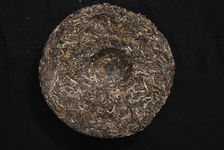
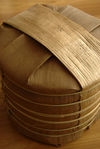
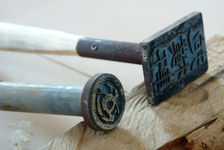
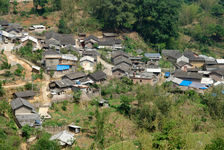
- 1. Galette compressed puerh
- 2. Tong cakes puerh (Pu Er tea) 7
- 3. Marking of traditional fire-flops
- 4. Wu Yi, the origin of many large families producer
Thus a certain Han culture is established around this tea gradually, supporting increased production quality and demand for a quality product. It categorizes such as the 1800 tea puerh (Pu Er tea) depending on soil where it originated, but also the season of harvest and leaf quality, and is a real demand for tea recognized as superior. The producers are also beginning to differentiate themselves from each other and to be recognized, which is reflected particularly through'' apparaission of Fei Nei, these small sheets printed with the image of the producer and slid between the tea leaves before compression. The appearance of false is also increasingly common with the growing recognition for a particular producer or production area.
But if there's much appartition in Yunnan and mainland China such a culture of tea puerh, ranging from the classification of soils to compression wafers through work sheets, and aimed at a better understanding and increased quality, instead é contribution to the question of maturation is mainly associated to more mysterious. Is there a culture of their aging puerh (Pu Er tea) in mainland China in the 19th and the early decades of the 20th century?
It is common, especially in Hong Kong and Taiwan to find that Yunnan has never consumed puerh (Pu Er tea) old, and that this culture is typically Hong Kongaise (where it will not appear until the 20 th century). This appears also naturally supported by the absence of consumption puerh (Pu Er tea) old in Yunnan today, where people eat almost exclusively puerh (Pu Er tea) young or old for a few years and where the oldest puerh (Pu Er tea) are almost unobtainable. However, it is a little simplistic to rely on this single finding of the current situation and it is necessary to put this in context, including taking into account the 50 years of communism and cultural revolution that radically swept culture in place before 1949, including culture and the practices related to tea.
Other elements also allow doubt of a true culture of ancient maturation puerh (Pu Er tea) tea in China. I think first of all to my knowledge the lack of written documentation relating to the period puerh (Pu Er tea) with a clear maturation puerh (Pu Er tea) mentioned, while there are many different documents and document more precisely the tea to puerh (Pu Er tea) from the 1800s. If they classify such soils considered the best, detail the quality criterion of leaves, their authenticity or different seasons of harvest, there is never to my knowledge against issue of post fermentation or natural maturation or artificial tea ...
More troubling is noted that the cakes puerh (Pu Er tea) produced before the first factories status was never refers to the year of production of tea. Although these cakes are accompanied by various printed elements included in the cake itself (Nei Fei), with each stack of pancakes 7 (Tong Piao), or directly tamponés or burned onto the surface of the bamboo tong, and that these inscriptions give us different information when the harvest season or at the origin of leaves, no production year there appeared. Or it may appear strange for a product that one is supposed to keep for decades so that it gets better, no production date is not on this one, especially when these patties were produced by same producers for several hundred years ...
It is ultimately only after 1949, and after standardization of the tea sector by the Communist government, a dating system is set up. And yet, note that it is not directly for the consumer, the date of production or not yet listed on the wafer or on the tong retail only, and so coded, the plug accompanying technical jian (unit 84 patties). It will thus wait for the years 2005-2007, the booming puerh (Pu Er tea) to see become general registration dates on production wafers, which is enough to make a custom rependue doubt retain its puerh (Pu Er tea) to the transformation of its flavor has been in place in the last century.
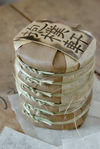
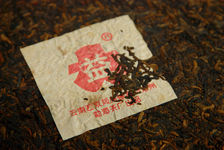
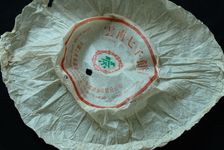
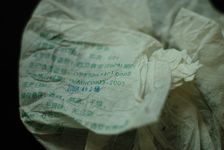
- 1. Tong Puerh
- 2. Fei Nei puerh (Pu Er tea) a cake
- 3. Packing of puerh (Pu Er tea) in the 90
- 4. Date on a package of puerh (Pu Er tea) in 2006
However, further study of ancient Tong Piao, these printed sheets accompanying descriptive tong (stacks of pancakes puerh (Pu Er tea) 7) show the most amazing things that evoke goods directly or indirectly post-fermentation and aging of puerh! Well first of all in Tong Piao puerh (Pu Er tea) products in the 1930s by Cheshun Hao Hao Tongxing and Tongchang Hao, found included among the properties of these teas nature "not cold" tea (Tongxing Hao) the ability to see to "chill chaser" (Cheshun Hao Hao Tongxing). But this cold is to be taken in the sense of culture and traditional Chinese medicine, which is attributed to particular properties of foods hot or cold, from which flow a different action on organsime. So far nothing if not disturbing that the tea is hot by nature, and only a post-fermented tea or fermented can be seen as cold, this line thus clearly indicating that the tea in question would be "fermented" or " post-fermented. " In the same vein is on the Tong Piao puerh (Pu Er tea) a product 10 years later by a description of Hao Tongqing puerh (Pu Er tea) as having a red liquid, which may just be the result of fermentation or artificial of a long maturation.
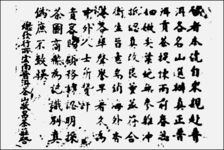
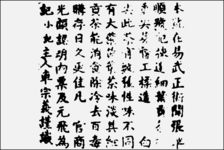
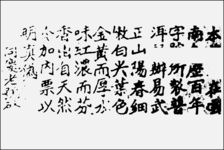
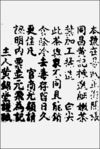
- 1. a former Tong Piao (Jingchang Hao 1940)
- 2. a former Tong Piao (Cheshun Hao 1930)
- 3. a former Tong Piao (Tongqing Hao 1940)
- 4. a former Tong Piao (Tongchang Hao 1930)
But still more in two Tong Piao, the contents are almost identical and the accompanying puerh (Pu Er tea) Cheshun produced by Hao and Hao Tongchang in the 1930s, is clearly writing for the consumer that this tea will be better with time, indicating conclusively that this belief was already inked in China since 1930.
These cookies by doing one of the oldest cons cakes puerh (Pu Er tea) to have lasted it is unclear whether this culture of maturation in 1930 raised by these historical producers, was indeed a custom practiced by them for a long time, whose foundation dates from 19th century, or if it was a new phenomenon emerged in the early 20th century. Since 1930 also coincides with the beginning of the puerh (Pu Er tea) export to Hong Kong, as appears elsewhere on the wafer Tong Piao Jingchang Hao and Hao Jiangcheng or puerh (Pu Er tea) is presented as a tea which sold particularly well in Hong Kong, where and as we shall see the tradition of maturation puerh (Pu Er tea) is quite different.
Always in favor of an ancient culture of the maturation of puerh (Pu Er tea) a Chinese saying, that we often hear and is said to come from a distant past said that they produce (or buy) the puerh (Pu Er tea) today that his children will drink tomorrow. Regarded by many as a trace of an ancient culture puerh (Pu Er tea) of aging in China, yet we can not place undue reliance on this saying. I did not initially found its origin, or traces of ancient its use, and this saying may well have appear or be transformed in recent years. Also see in this an apology for saying the maturation of puerh (Pu Er tea) is also a shortcut a bit fast. Behind the fact of storing tea, rice, salt, or other commodities, especially expensive, is also a desire to avoid potential savings for hard times, and by extension provide more security to his children, personal savings is something deeply rooted in Chinese culture, especially within families and in the countryside.
That said it will be found still today there is still a number of stocks puerh (Pu Er tea) old, often preserved with great care, some dating back over 100 years, which still tends to show a good special status to tea and a desire to keep the long term, and which is obviously not the case of all food or all the teas. Besides the famous imperial storage which we have spoken, have also existed a number of private storage preserved for generations.
If many of these teas carefully preserved since ancient times for over 100 years have disappeared with the Cultural Revolution, some have survived to us and are for the most part in Hong Kong, Taiwan and Malaysia, where an entire culture tea-old has formed around these teas from Yunnan.
Hong Kong, and wet storage market explosion puerh (Pu Er tea) old
The puerh (Pu Er tea) made its appearance in the landscape Hong Kongers in the 1930s. The Hong Kong for 30 years, with a population of less than one million inhabitants, is far from the image we can see today. Overall relatively poor, Hong Kong is also home to an affluent population especially after Shanghai. The first tea house in Hong Kong seems to emerge in the late 19th century. Develops from there culture Dimsum (点心) and Yumcha (饮茶), originally came from the Canton region. Typical Hong Kongaise culture, it is a form of popular tea room where people come to meet, eat small meals, often with steam (Dimsum) and drinking tea (Yumcha), friends , co-workers or family. Despite the limited population of Hong Kong, these tea houses swarmed in the old days, and were, as teahouses in Sichuan, a central feature of everyday life.
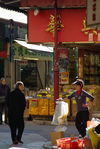
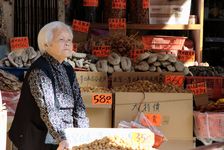

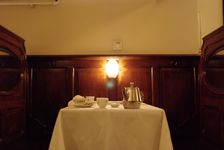

- 1. Old streets of Hong Kong
- 3. Luk Yu Tea House, one of the oldest Yumcha Dimsum Hong Kong
- 4. Luk Yu Tea House, one of Dimsum Yumcha the oldest in Hong Kong
- 5. Luk Yu Tea House, one of the oldest Yumcha Dimsum Hong Kong
Thus Hong Kong began importing and consuming puerh (Pu Er tea) from the 1930s. Besides cheap teas to accompany the meal, Hong Kong is also beginning to import, easy for a minority, high quality teas, including puerh (Pu Er tea) quality. Although production of such high-end puerh (Pu Er tea) is still very limited in these times, a number of wafers of large families such as Tong Qing Hao, Tong Tong Shun Chan and Xiang, whose production rarely exceeded 50 tons per year, is found in Hong Kong since the 30s and some are still stored today. This import is still very moderate, the high prices of these teas and according to some merchants import annual pancake quality in Hong Kong in the 30s did not exceed 10 baskets (840 patties about). Compared to the overall market very limited puerh (Pu Er tea) quality, Hong Kong will still figure preferred importer in the '40s, into Yunnan, Fei Nei's a number of major producers of wafers 40 years putting forward that this tea is very popular in Hong Kong.
Yum Cha Dim Sum Hong Kongers traditional storage
It is from the 1950s that the status of Hong Kong puerh (Pu Er tea) takes a different dimension. With the passage of China to communism, the puerh (Pu Er tea) gradually becomes an industrial production that is more popular, and which the state hopes to benefit, particularly through exports. Meanwhile, the coming to power of the Communist Party leads to a large wave of immigration to Hong Kong which saw the arrival of many refugees, often poor. Overwhelmed by this sudden and rapid immigration, life, landscape and the everyday habits of Hong Kong quickly adapts to the situation.
Large blocks of homes, real cities in the city are emerging here and there to replace the camps where many immigrants had found refuge. In any other field this large wave of Chinese immigration exploded demand for tea in Hong Kong cheap, particularly to supply the many tea houses in the city. Puerh tea, at least in its most popular, being particularly cheap against other Chinese teas, and is a perfect answer to meet this demand. Thus, as was the case of Tibet around 1000 years ago is as Bian Xiao Cha, cheap tea for export, as in the 50 years between puerh (Pu Er tea) truly in everyday Hong Kongers.
But the puerh (Pu Er tea) product at this time by the Chinese state factories was green, that is unfermented, which did not suit the palate of Hong Kongers. The bitterness of puerh (Pu Er tea) particular, may be even more present on the cheap tea was exported to Hong Kong, Hong Kong people the bother. Probably observing the darkening of the leaves and the transformation of aromas caused by a storage cellar, especially in a humid atmosphere like that of Hong Kong, will grow gradually the practice of what is now known as Hong Kongers storage or storage wet. The goal is to transform a product purchased very cheap, the green puerh (Pu Er tea) Yunnan, something nice to drink that can inspire the market Hong Kong people: a dark tea, round and smooth. For this we artificially accelerates the post-fermentation and processing the leaves of puerh (Pu Er tea) allows subjecting them to certain conditions, or time, humidity and temperature play a crucial role.
But it is not enough to make piles of rotting in a damp cellar puerh (Pu Er tea) to achieve a satisfactory result, Hong Kongers and storage become as and when the years a subtle and complex, requiring subtlety and skill. After spending some time in a particularly humid atmosphere, the tea should especially spend a few years in a drier atmosphere to stabilize and losing odors related to storage. The same care should be taken to assay the storage conditions to avoid over-fermented tea, but also to constantly move the position of the batteries of teas to homogenize the result, and of course to specifically track the processing of tea as and the years to adapt the storage conditions accordingly.
To illustrate this I suggest you try a puerh (Pu Er tea) gross, so green, produced in Yunnan in the 90s and then stored in a traditional way to Hong Kong, before being sent to Taiwan.
 Chargement du thé...
Chargement du thé...Thus such a transformation needs space but also time, 5 to 10 years being the minimum to achieve a satisfactory product. Or tea rooms Hong Kongers, these famous Dimsum Yumcha are more like huge restaurants that what we imagine today tearoom, and virtually always full of little lunch at sunset consuming huge quantities of tea. Thus for their consumption and turnover of their stock different tea houses of the city had to store each year large quantities of puerh (Pu Er tea) to consume a few years later. To distinguish themselves from the competition it was also necessary to better control the conditions to storage, to get the best tea can mature, or sometimes simply to speed up the rate of maturation of teas to be stiffly over goods and minimize inventory. If the fermentation of puerh (Pu Er tea) was inappropriate and had tea aroma unpleasant, it was common for traders added flowers, including chrysanthemum flowers to hide in some ways the residual aroma of fermentation, the puerh (Pu Er tea) to flower chrysanthemum tea and thus has become a typical Hong Kong, always appreciated and consumed either Hong Kong or Taiwan.
But this transformation requires a lot of time and space, while the rest puerh (Pu Er tea) at that time a popular and inexpensive, making the production of mature puerh (Pu Er tea) unprofitable. Thus the technique of post-fermentation Hong Kongaise was taken on the mainland Chinese in the Canton area, where space and labor is cheaper and Canton will begin feeding partly in Hong Kong puerh (Pu Er tea) mature, produced locally from green puerh (Pu Er tea) bought in Yunnan.
Towards the end of the 50 different techniques will be developed to improve in Canton but also accelerate the process, and produce more quickly and easily from the market for dark puerh (Pu Er tea) Hong Kongers. Accompanied by a work of marketing and communications around the name puerh (Pu Er tea) this marks a new progress in the success of post-fermented tea.
Shu Cha, ownership Yunnanaise post-fermentation Hong Kongaise
Market puerh (Pu Er tea) dark, artificially fermented in Hong Kong or Canton becoming increasingly important, particularly in Hong Kong but also overseas, one begins increasingly to address the issue in Yunnan and ability to produce straight from the source to the taste of a puerh (Pu Er tea) Hong Kongers. Thus in 1973 Menghai Tea Factory, a large state factories puerh (Pu Er tea) an expert panel shipments in Canton, one of which is Zou Bing Liang , to study the artificial fermentation techniques were practiced.
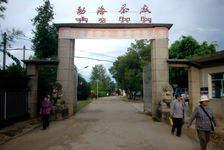
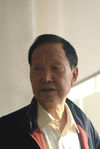
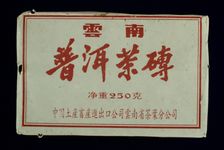
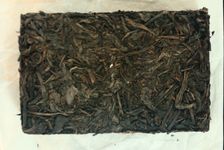
- 1. Entry Menghai Tea Factory
- 2. Zou Bing Liang, one of the main contributor to the creation of Shu Cha
- 3. First of puerh (Pu Er tea) fermented goat out of Menghai Tea Factory
- 4. First of goat puerh (Pu Er tea) fermented out Menghai Tea Factory
On their return, and despite a certain distrust of those who then held in Canton a large market share of post-fermented puerh, Zou Bing Liang publish the first book detailing the technical phenomenon of post-fermentation puerh. In the months that followed as developed and tested in Kunming Tea Factory Tea Factory and Menghai technique called Wo Due (渥 堆), or accelerated fermentation of puerh (Pu Er tea) versus Chinese. Where it takes at least five years to reach a level of post-fermentation with suitable methods practiced in Hong Kong, the new methods implemented in Yunnan require less than 2 months, a small space and a lower labor .
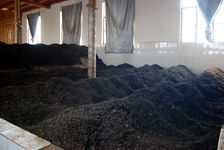
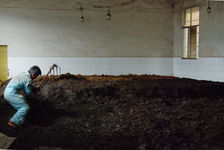
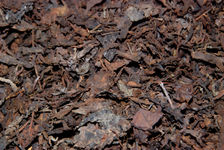
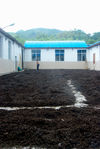
- 1. Fermentation of puerh (Pu Er tea) (Wo Due) in Yunnan, Kucong Cha Chang, Pu'er
- 2. Fermentation of puerh (Pu Er tea) (Wo Due) in Yunnan, Lan Ting Chun, Yong De
- 4. Fermentation of puerh (Pu Er tea) (Wo Due) in Yunnan, Lan Ting Chun, Yong In
The leaves are green puerh (Pu Er tea) why piled, sprayed with water and covered with tarpaulins to isolate them from ambient air. Occur well within the cell fermentation similar to that produced in a storage Hong Kongers, but much faster. As is the case in a traditional wet storage leaves are then drained and ventilated to lose odors associated with fermentation and take their balance. If the result is not the same as a tea from Hong Kongers storage, the cha shu produced in time, from a light and balanced fermentation comes close anyway, and will become popular, especially in Hong Kong . Even today the puerh (Pu Er tea) of under 5 years consumed in Hong Kong are generally fermented Shu Cha in Yunnan, there puerh (Pu Er tea) or older are fermented in Hong Kong or Canton.
To illustrate this I suggest you eat a cake of fermented puerh (Pu Er tea) produced in 1996 by Chun Lan Ting and has the rare distinction of never having left the Yunnan. So after over 15 years of storage in dry natural Pu'er, this brick has not been subjected to artificial aging after compression, we referenced in another time and témoingne of what could be a puerh (Pu Er tea) fermented in the year in the 90s.
 Chargement du thé...
Chargement du thé...
However, despite the one hand puerh (Pu Er tea) fermented product in Yunnan and the other the practice of wet storage increasingly widespread in the Canton area, the culture of aging puerh (Pu Er tea) still remains firmly rooted in Hong Kong even , where tons of older puerh (Pu Er tea) continue to sleep peacefully in the stock of tea houses in the city. This culture persists even today and also some famous tea houses continue to produce fermented puerh (Pu Er tea) post to the former, despite the astronomical price of real estate in Hong Kong and therefore teas and products.
Also behind the traditional storage Hong Kongers it first there's the question of time. Thus the tradition of conservation puerh (Pu Er tea) the long term is central to Hong Kongaise culture, and goes beyond the question of fermenting a puerh (Pu Er tea) green. It has become common in Hong Kong of aging the tea puerh (Pu Er tea) it was fermented or not initially leYunnan or Canton.
And the cha shu produced in Yunnan is still for many Hong Kong people through a new phase of post-fermentation fashionable Hong Kongaise to land and take in the scale it needs to express it fully, and It is true that this type of puerh, although already fermented in Yunnan, find themselves transformed after several years of aging in Hong Kong ...
Let's see what it can give a bulk of 1998 in Yunnan fermented, then aging in Hong Kong in a quality stock.
 Chargement du thé...
Chargement du thé...Lets see another example: the influence that Hong Kongers a wet storage on a recipe of fermented best known: a 7572 Menghai Tra Factory in its 1997 vintage, the first cake to take the red color of Da Yi.
 Chargement du thé...
Chargement du thé...Speculation and renewed interest in the old puerh (Pu Er tea)
In the 90s while the return of Hong Kong to China approaches and scares, many people sell their businesses and leave Hong Kong for overseas. Thus a number of teahouses sell their stocks, in which there are many puerh, sometimes aged for decades, and whose value at the time was ridiculous.
Among the buyers attracted by the cheap stocks of tea are many Taiwanese, the economic power and highest known for their sense of business, which explains in particular that Taiwan is now with Hong Kong and Malaysia's largest puerh (Pu Er tea) old tank. But the opening of these stocks of tea that does not interest abroad and many sellers of Hong Kong also seize this opportunity and fill the warehouses of these aged teas without necessarily assess what this would represent a few years later.
What follows is a complex phenomenon of speculation and valuation of these teas, including orchestrated by Taiwanese vendors, leading to strong growth in the prices of these aged teas. The status of everyday consumer product which is not wearing a lot of attention, the end product becomes a puerh, rare and sought after. Accompanied by various big name and tea specialist, as Deng Shi Hai in Taiwan who published a book on the cult became puerh (Pu Er tea) in the 90, or Vesper Chan and Winchi Ip Hong Kong, a culture around the teas of the past is established gradually in Hong Kong and Taiwan. We simply no longer consumes the beverage as puerh (Pu Er tea) pleasant but we try to understand these teas, their specificities, their stories, their origins.
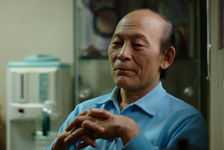
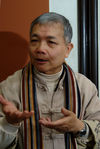
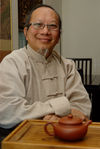
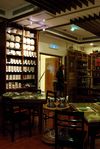
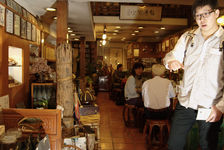
- 1. Deng Shi Hai, an instigator of the culture in Taiwan puerh
- 2. Vesper Shan, an instigator of the culture of Hong Kong puerh
- 3. Winchi Ip, an instigator of the puerh (Pu Er tea) culture in Hong Kong
- 4. Lock Cha Tea House in Hong Kong
- 5. Yabo cha fang in Hong Kong
A new market of older tea lovers in search of quality teas and sees the day, especially in Hong Kong, Taiwan, and Malaysia. Buoyed by rising prices and demand for tea-old high-end care is taken to new storage teas and traditional techniques of maturation. There is no question of simply darken the puerh (Pu Er tea) into a consumer product to taste Hong Kong people, but to produce an end product, respecting and glorifying the initial quality of tea. Different specialists and tea houses and lean on the techniques of storage and ripening puerh, and refine empirically the processes in place, helping to develop the culture of Hong Kongaise puerh (Pu Er tea) old. A number of tea houses and continue to practice this form of artificial fermentation of traditional Hong Kong, and since buying the 90 teas that 5 to 10 years later after a maturation conscientiously followed.
Thus see two puerh (Pu Er tea) for products respectively in 1996 and 1997. Initially green (sheng cha) both have left the bulk Yunnan upon production to be finely and slowly fermented in a traditional storage of Hong Kong. Similar to their production, these two teas have undergone slightly different storage conditions, the 1996 vintage has been stored substantially wetter than the 1997 production, which is clearly reflected in the character of these two teas.
 Chargement du thé...
Chargement du thé... Chargement du thé...
Chargement du thé...
Alongside with this demand for a product finely ages Hong Kongaise according to tradition and the search for a perfection of taste in this post fermentation, appears also in the 90s in Hong Kong the concept of dry storage. Widely promoted by Vesper Shan, a key figure puerh (Pu Er tea) tea in Hong Kong, this is not to follow the legacy of ancient tea houses, and places to artificially fermented tea let it age naturally. Notably popularized by the famous 88qing, a 7542 from the late 80's so dry stored, this storage causes a natural fermentation significantly slower, but mainly leads to different characters of what is practiced in Hong Kong of the past . Not only adopted by many tea houses, specialists, collectors and enthusiasts Hong Kong, this new mode of the natural maturation of puerh (Pu Er tea) from Hong Kong will also influence other countries like Taiwan or Malaysia, which since the 90 would not be satisfied buy more Hong Kong people aged teas will store but also young green puerh (Pu Er tea) from Yunann to make them age naturally on site ...
Notice however that the conditions of such a maturation "natural" course of flow conditions in which the tea is stored. If in principle the natural storage of tea in Hong Kong may well be similar to what can be done in China in the past, the character of a tea stored in the ambient humidity of Hong Kong will differ greatly from character of an aging tea in Yunnan, but also a naturally aging tea in Taiwan and Malaysia, each country has a climate all its own.
See for example the case of two rough puerh (Pu Er tea) stored in a natural way. The first is a brick CNNP produced in 1984 has never left Yunnan, which is very rare, and has been stored for nearly 30 years in Pu'er in a dry atmosphere really. The second is produced by a slab CNNP Menghai Tea Factory in 2001, a famous 7542, stored since its production in Malaysia, in a relatively humid atmosphere and very stable, Malaysia has the distinction of not having real seasons.
 Chargement du thé...
Chargement du thé...Turning now to a radically different character tea, a cake of 7542 produced in 2001 and stored in a natural way in Malaysia. Although far less aged, and also stored in a natural way, this tea has a pronounced post-fermentation, but also is clearly the result of maturation that produces the typical Malaysian climate.
 Chargement du thé...
Chargement du thé...Furthermore this research a Master of maturation parameters and the desire to achieve a certain excellence, the 90 year mark as Hong Kong and Taiwan the beginning of a certain frenzy for the collection of antique tea. Closest to the antiquities market, that the collector will often search primarily the scarcity of the product and its authenticity, which result from its value. Series of short supply, identifiable by such and such details, including the packaging, make some tea and particularly expensive and sought after by collectors, sometimes regardless of the true value of the tea flavor. Such teas are rarely drank collectors, who either see them as economic investments, either as relics of the past as well as antiques or other cultural object, giving a new facet to the world of old puerh (Pu Er tea) .
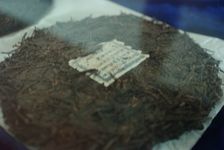
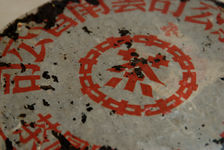
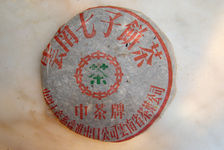
- 1. Pattie collectiom (Tong Hao Chang), before 1949
- 2. Pattie collectiom (Red Mark), 50 years
- 3. Pattie collectiom (Mark Zhong Cha traditional character), 80 years
fermented Puerh contemporary reappropriation Yunnanaise to a post-fermentation?
Thus despite early puerh (Pu Er tea) fermented probably produced by different ethnic groups living in Yunnan there are over 1000 years ago, but also the probable production of Yunnan puerh (Pu Er tea) dark for at least 30 years as suggested by Nei Fei d 'old cakes puerh, culture or fermented puerh (Pu Er tea) ages seems to have developed mainly in border regions such as Tibet or, more recently Hong Kong, Taiwan and Malaysia.
The creation of Shu Cha, puerh (Pu Er tea) artificially fermented by Wo Due, in the 70s, was primarily an economic re-appropriation, and not cultural. Directly producing the dark to the market puerh (Pu Er tea) Hong Kongers and outside Yunnan removes an intermediary, but also by accelerating the process increases the amount of puerh (Pu Er tea) available on the market, allowing the expansion of exports. The model gustatory up against was that posed by more than 30 years ago in Hong Kong, the main objective being to produce a similar tea directly in Yunnan and a single shot. Thus far 90 of the fermentation Shu Cha Yunnan is usually mild and, in particular with several years of maturation, comes very close to the fermentation of tea from traditional storage Hong Kongers.
But the gradual fall of communism in China, the opening of the tea market in the late 90s and the emergence of a new generation of private producers seems to change the situation and open a new path to the post-fermentation. If indeed the production of Shu Cha had much in its infancy vocation to imitate the old puerh, contemporary producers who have inherited these technical issues are far from the 70s. Person consumes virtually puerh (Pu Er tea) old in Yunnan today, where it is even difficult to procure. So many producers puerh (Pu Er tea) current, including producers Cha Shu is not any culture puerh (Pu Er tea) old, and many of them have never even eaten puerh (Pu Er tea) old or from traditional storage Hong Kongers.

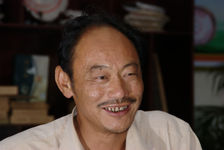


- 1. A new generation of producers in Yunnan Shu Cha (Cha Chang Kucong)
- 2. A new generation of producers Shu Cha in Yunnan (Lan Ting Chun)
- 3. A new generation of producers in Yunnan Shu Cha (Cha Shan Chang Jinuo)
- 4. A new generation of producers Shu Cha in Yunnan
Fermentation techniques of Tomorrow's puerh (Pu Er tea) as they are practiced in Yunnan were gradually separated from the model that had motivated their development. In the hands of many current producers of these techniques are used very loosely to sculpt the aromas of tea, and the emergence of new characters, not referring more to the tastes of the past, often based on their own assessments or personal taste. Far from the old flavors of teas and charm of the past and we find ourselves in a world of new taste, which can also play well in a book light and fruity, woody in the keys of walnuts and hazelnuts, or otherwise in a heavy intoxicating.
Become a true fermentation technique unique to Yunnan, Hong Kongers model released and with its own quality standards, this new use of post-fermentation artificial can be seen as a reappropriation of these techniques, and may constitute the basis for a new family of puerh (Pu Er tea) typical fermented in Yunnan.
This is for example the case of a small producer of Pu'er, Kucong Cha Chang, for example in 2008 which produced a puerh (Pu Er tea) fermented wholly unique and beautiful.
 Chargement du thé...
Chargement du thé...Latest example of innovation and personal reappropriation of fermentation technique to finish this article: a unique tea produced by Lan Chun Ting in 2010 from white buds. Borrowing and to both the technique of white tea and that the fermentation of puerh, Lan Chun Ting product something unique that makes rethink the potential of the fermentation ...
 Chargement du thé...
Chargement du thé...
